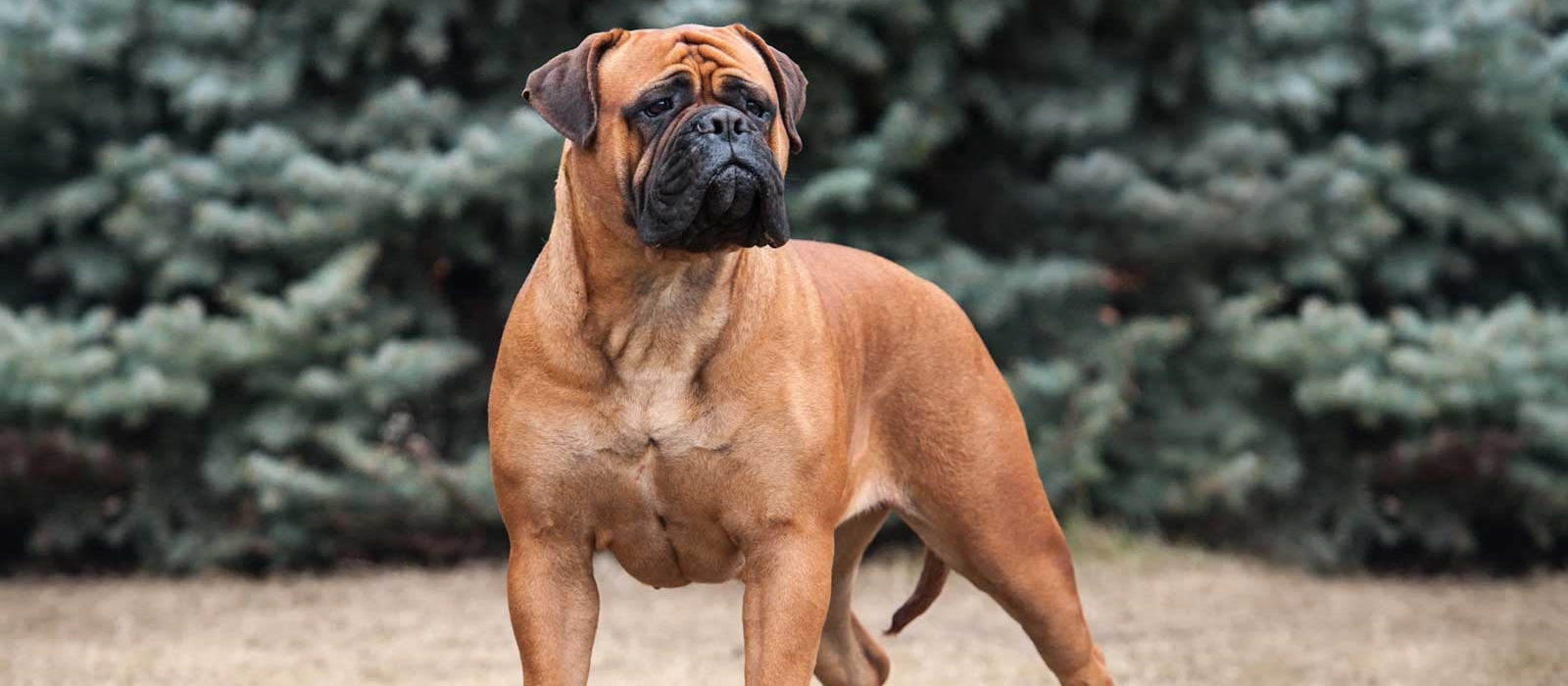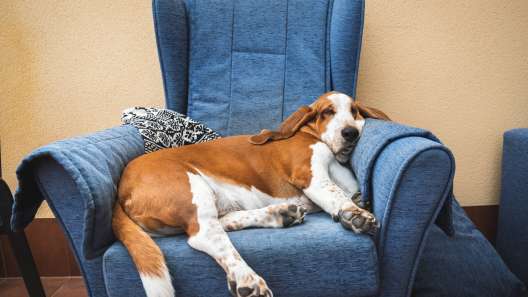-
Activity Level:
low
-
Shedding Level:
low
-
Grooming Level:
low
-
Trainability:
moderate
-
Good for Novice Owners:
moderate
-
Adaptability:
moderate
-
Kid/Pet Friendly:
often
-
Prey Drive:
moderate
-
Watchdog:
aware
- Average Size: Large
- Average Lifespan: 7-9 years
- Registered?: aca, akc
Bullmastiff Dog Breed Information
Overview
Temperament
Adaptability
Health
Owner Experience
Grooming
Activity Level
Size
Life Span
Did You Know?
The Bullmastiff originated in England in the mid-to-late 19th century and was known as both a world-class guardian and a valued family companion. They were bred by crossing Bulldogs and Mastiffs to create an excellent guardian that would protect the vast lands of English aristocracy from poachers. They were prized as noble gamekeepers.
As competitions between the aristocracy rose to determine who had the best Bullmastiffs, the breed made the jump from being solely a working dog to being both a working dog and a show dog. By 1924, the breed joined the Kennel Club in England.
The American Kennel Club recognized the Bullmastiff in 1934 as a member of the Working Group. One of the facts about bullmastiffs is that although they can still be found as working dogs, modern bullmastiffs are most commonly found as family pets and companions.
Although their size may make them intimidating, the Bullmastiff is known for being a docile, warm, loyal, and loving family dog. They are focused and determined while working and relaxed and affectionate while at home.
Well-socialized, they tend to get along well with children and other dogs in the family. Although they get along with children, their large size means they can easily knock over small children in their excitement. So, any interactions between young kids and puppies should be closely supervised.
Because of their protective instincts, they are wary of strangers and strange dogs at first. Proper socialization and training early and often can help make a Bullmastiff more comfortable with strangers. A well-socialized, well-trained Bullmastiff may be initially suspicious of strangers, but they will warm up quickly.
The Bullmastiff is a moderately adaptable dog breed. They are best suited to larger homes with securely fenced yards. They do tend to be mellow dogs, so they can adapt to apartment living as long as they are given the daily exercise, mental stimulation, and attention they need. They are even considered one of the best large dog breeds for small homes.
They do well in most climates, but are very sensitive to heat and sensitive to extreme cold. Although they can handle some alone time, they are devoted to their families and should not be left alone for long periods of time. Also, they are one of the dog breeds that are good guard dogs, which means they can be territorial. Due to their territorial instincts and urge to patrol what they consider their territory, they should only be let off-leash in securely fenced areas.
Although the Bullmastiff is a relatively healthy dog breed, there are some potential health concerns to be aware of. These potential issues can include heart problems, eye issues, hip dysplasia, elbow dysplasia, and hypothyroidism. Good breeding practices and the health of the parents make a big difference in the health of Bullmastiff puppies.
Reputable breeders will screen their dogs to avoid passing on issues like this to puppies. So, don’t be afraid to talk to the breeder about the genetic and health history of both parents. You can also ask to see any relevant health clearances or test results. The American Bullmastiff Association, Inc. recommends a cardiac exam, an elbow evaluation, a hip evaluation, an ophthalmologist evaluation, and a thyroid evaluation.
As with many large dog breeds, the Bullmastiff is at a higher risk for bloat. Because bloat in dogs can be dangerous and quickly becomes fatal if the stomach flips (i.e.; gastric torsion occurs), it’s important to know how to reduce risk and what symptoms mean that it’s time to get to the vet as soon as possible.
Although a Bullmastiff tends to excel at consistent training, they tend to be strong-willed, which makes them a better fit for more experienced dog owners. Their stubborn streak paired with their guardian background, territorial instincts, and large size make good training and socialization early and often essential.
Puppy training classes are recommended for both early training as well as opportunities to socialize a puppy. This will help to establish rules and routines early on and help keep things consistent as your big puppy grows into a large dog. As a working dog, you can also train your Bullmastiff for dog sports to help give them a job to do. They tend to excel at rally, tracking, scent work, obedience, and even agility.
The Bullmastiff has a short coat that will shed a little year-round and a little more during seasonal changes. Brushing their coat a few times a week and the occasional bath as needed are usually sufficient to keep this dog’s coat healthy and looking great. A bristle brush, a round brush or rubber brush, a grooming glove, and a shedding blade are some good types of dog grooming brushes to have on hand to keep your Bullmastiff’s coat looking great.
Because they have a wrinkly face, you will also need to regularly check and wipe down wrinkles to make sure they are clean and dry. Bullmastiffs will also drool, so you may want to keep a drool cloth on hand to wipe their mouth periodically.
In addition to coat and wrinkle care, you will also need to care for your Bullmastiff’s nails, ears, and teeth. Cutting your dog’s nails once or twice monthly is usually sufficient, but you may need to trim nails more often if they grow quickly or aren’t wearing down as much naturally.
Checking ears on a weekly basis and carefully cleaning your dog’s ears as needed can help prevent ear infections. You want to make sure ears are clean, dry, free of debris and pests, and aren’t showing signs of irritation or redness.
Practicing good dental care for dogs is essential for preventing painful dental diseases later in life. Brushing your Bullmastiff’s teeth or using an enzyme toothpaste every day, in addition to cleanings at the vet when needed, is ideal for preventing gum disease, tooth decay, and tooth loss as your dog ages.
Because your Bullmastiff puppy will grow into a large dog, it’s a good idea to get them used to these basic grooming tasks early on. This will make ongoing maintenance and care much easier as your puppy grows. It can also help you build a bond with your dog and could even become something your dog looks forward to.
The Bullmastiff has moderate exercise requirements. Although they can be one of the laziest dog breeds and they may be couch potatoes at times, they also still need daily activity to be happy and healthy. Daily walks plus some playtime or other activity are usually enough for this big dog.
Although they enjoy outdoor play, it’s important that these dogs are only let off-leash in securely fenced areas because they tend to be territorial. As a large dog breed, it’s also important not to overexercise them until their bones are done developing.
Although puppies finish growing at different rates, most large dog breeds that weigh more than 70 pounds as adults continue growing until they are 2 years old. Your vet can help you determine when your Bullmastiff is done growing, so you know when you can allow them to do more rigorous activities without potentially causing damage to developing joints and bones.
A fully-grown Bullmastiff usually stands 24-27 inches tall and weighs 100-130 pounds. Females tend to average 24-26 inches tall and weigh 100-120 pounds while males tend to average 25-27 inches tall and weigh 110-130 pounds. This makes Bullmastiffs one of the largest dog breeds.
Bullmastiffs generally live for 7-9 years on average.
While the Bullmastiff was protecting the lands of the aristocracy, they were often called the “Gamekeeper’s Night Dog”. Bullmastiffs have even been presidential pups. Franklin D. Roosevelt had several dogs with him in the White House. Although Fala the Scottish Terrier is considered one of the most popular presidential pups of all time, one of Roosevelt’s dogs was a Bullmastiff named Blaze.









